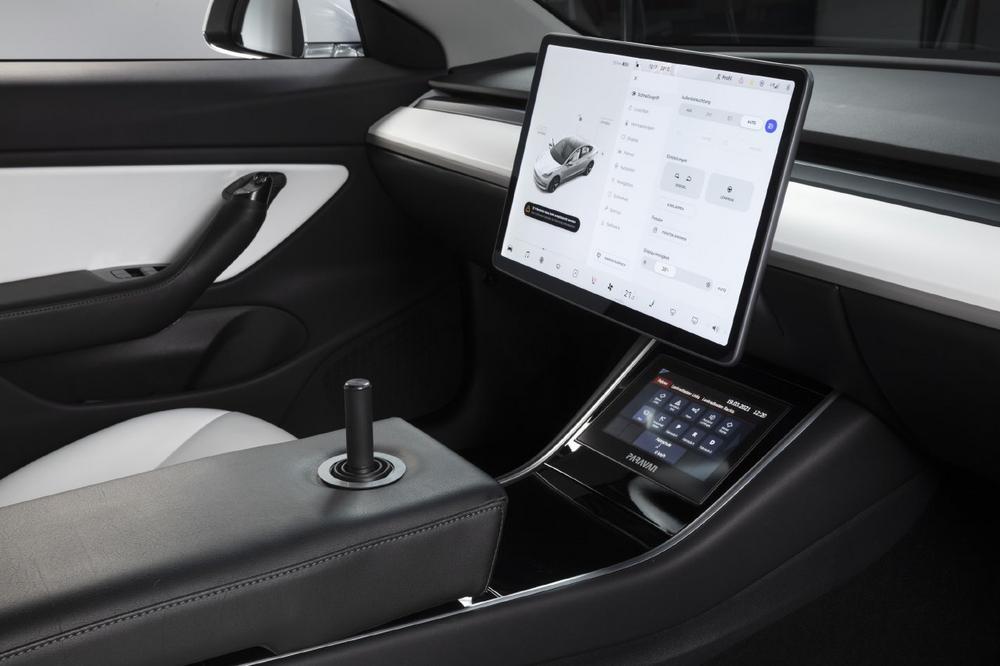Mobility for All Thanks to Autonomous Driving?
Today, existing assistance systems can already offer significantly more options for people with disabilities, combined with a significant increase in safety: be it adaptive cruise control, lane departure warning or digital comfort steering with up to 8 N. In some cases, automatic parking and unparking or vehicle control via smartphone are no longer visions of the future.
If vehicles are perhaps already equipped with a standard dive-by-wire system in a few years, this will make it easier, for example, to integrate customizable control devices such as joysticks or accelerator-brake sliders. More cost-effective solutions could also ensure mobility into old age for a larger group of people – such as retirees, for whom a conversion is no longer financially viable without a cost carrier. Digital accelerator-brake systems also offer greater safety compared to mechanical handheld devices.
Level 4 and 5 autonomous driving could also give more people with a handicap access to independent mobility. But there are a number of hurdles to overcome before this can happen. The most fundamental question, will new vehicle concepts be designed to be inclusive bw. barrier-free from the outset? A basic prerequisite for this is, for example, a central control unit in the car that monitors autonomous driving functions – even in Level 3 or 4 – for example, whether the driver has his hands on the individual input device so that he can intervene in an emergency.
This is both a challenge and an important task for vehicle developers, because future input devices for handicap applications will also have to be continuously developed to communicate with the assistance systems in the vehicle, for example to provide hands on detection – reliable monitoring of functions. For example, under current General Safety regulations, an emergency steering assistant will be mandatory on new vehicle types from 2024. All these developments would offer additional safety.
Under these conditions, fully autonomous vehicles could enable people with disabilities to be mobile in the future, for whom this is not yet possible today due to their medical condition, also through new – inclusive – interior concepts.
Despite the many advantages, the idea of fully autonomous driving, of relinquishing control of the vehicle, is still something of a utopia for many, and hardly imaginable. "I certainly expect that my next car – planned for 10 years from now – will be at least partially autonomous, if not fully autonomous," says Janis McDavid. He was born without arms or legs and has relied on Space Drive and a four-way joystick to equip his vehicles for more than 10 years. "One of the more exciting questions for me from today’s perspective is, do I want to give up my autonomy completely to my vehicle? Would that mean, okay, I’m still driving for the first hour, but when I no longer feel like or have the energy to drive myself, I can say, so, car, now take over and drive me to my destination.
"New mobility concepts such as fully autonomous people movers could give many more people access to self-determined mobility. Also, not everyone would have to buy their own vehicle. But the vision is still a long way off. To realize it, future vehicle concepts need to be thought of inclusively right from the development stage. Questions like these would have to be considered during development: How can a blind person enter an autonomous vehicle? How will the wheelchair be secured, especially in view of the variety of wheelchair types, and how will this be controlled? Or what happens in the event of a medical emergency? FACT is, further individual assistance systems must be developed for this area of application. An autonomous vehicle alone will not be the solution in this case.
The vehicle industry is facing a disruptive change, in vehicle design and in the area of individual mobility. In order to be able to design mobility in a fundamentally barrier-free and sustainable way in the future, it will require the joint efforts of everyone: car manufacturers, vehicle retrofitters, research institutions, technical departments, health organizations, politicians and the users themselves. Otherwise, at least for the handicap sector, there is a risk of losing more than we gain.
Paravan GmbH is the world market leader for highly customized vehicle solutions for the disabled. Around 180 employees develop and produce individually adapted automobile conversions, power wheelchairs. Paravan pursues a holistic approach with its "all-in-one concept". The technological highlight is Space Drive, an intelligent digital control system based on the drive-by-wire principle. Thanks to the active redundancy of the servo motors, it is completely fail-safe and the first in the world to be approved for road use. With the help of this innovation, severely disabled people, some without arms or legs, can drive independently and safely. It is not possible for these drivers to simply intervene in the steering wheel. Worldwide, Space Drive has proven itself on over one billion road kilometers in the last 18 years and is used by numerous industrial customers for test vehicles in the field of autonomous driving. The system is available as a retrofit kit with an open interface for all known vehicle types. www.paravan.com
PARAVAN GmbH
PARAVAN-Straße 5-10
72539 Pfronstetten-Aichelau
Telefon: +49 (7388) 9995-66
Telefax: +49 (7388) 9995-999
http://www.paravan.de
Pressesprecherin
Telefon: +497388999581
Fax: +497388999581
E-Mail: anke.leuschke@paravan.de
![]()
